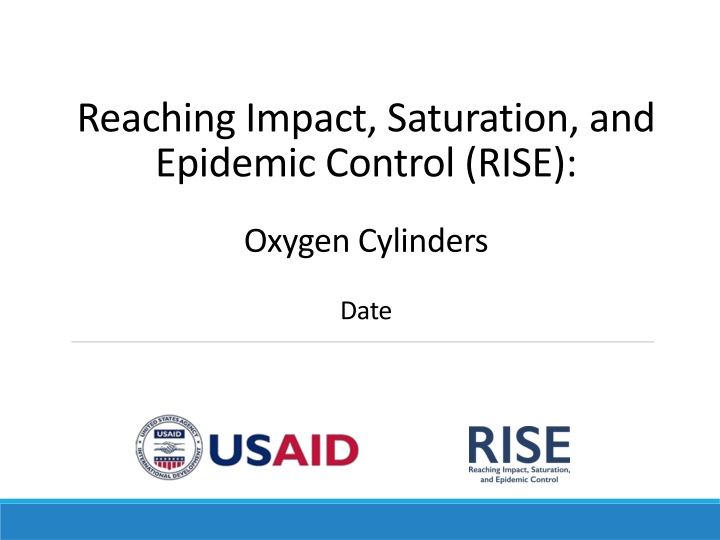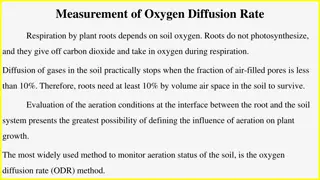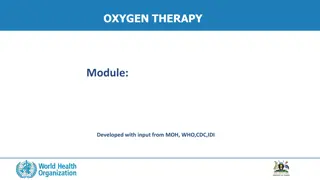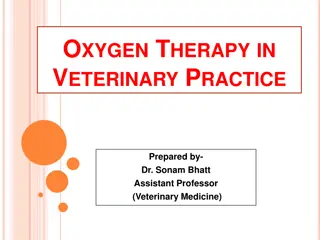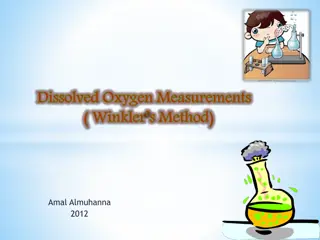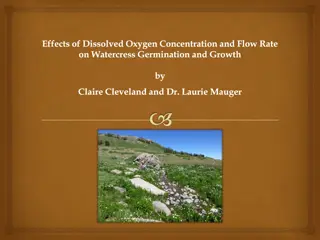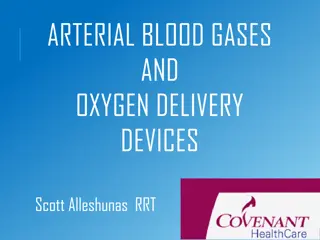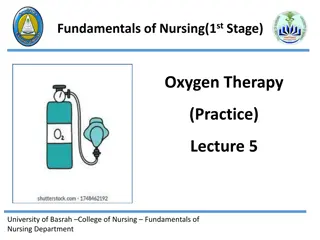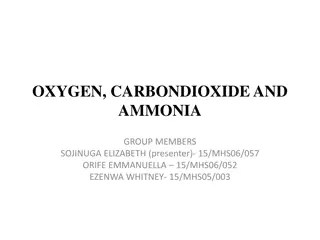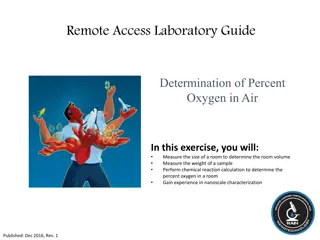Comprehensive Guide to Oxygen Storage and Handling Methods
Explore the various methods of storing and handling oxygen, including types of storage devices, sources of medical oxygen, liquid oxygen containers, and cryogenic liquid cylinders. Learn about the different containers used, storage quantities, vaporization rates, and safety measures involved in storing oxygen in liquid form.
Download Presentation

Please find below an Image/Link to download the presentation.
The content on the website is provided AS IS for your information and personal use only. It may not be sold, licensed, or shared on other websites without obtaining consent from the author.If you encounter any issues during the download, it is possible that the publisher has removed the file from their server.
You are allowed to download the files provided on this website for personal or commercial use, subject to the condition that they are used lawfully. All files are the property of their respective owners.
The content on the website is provided AS IS for your information and personal use only. It may not be sold, licensed, or shared on other websites without obtaining consent from the author.
E N D
Presentation Transcript
Reaching Impact, Saturation, and Epidemic Control (RISE): Oxygen Cylinders Date
Session: Components, Installation, And Handling Of Oxygen Cylinder REACHING IMPACT, SATURATION, AND EPIDEMIC CONTROL (RISE)
Types of Oxygen Storage Devices
Different Sources Of Medical Oxygen Cylinders Concentrators Oxygen plant (PSA) Liquid oxygen Clinical application and/or use case Can be used for all oxygen needs, including- high-pressure supply; facilities where power supply is intermittent or unreliable; ambulatory service or patient transport; backup for other systems. Primary, secondary, possibly tertiary (any medical unit requiring oxygen). Used to deliver oxygen at the bedside or within close proximity to patient areas. A single concentrator can service several beds Can be used for all oxygen needs, including high- pressure supply. Can be used for all oxygen needs, including- high- pressure supply and in facilities where power supply is intermittent or unreliable. Appropriate level of health system Primary, secondary, possibly tertiary (any medical unit requiring oxygen). Secondary and tertiary. Secondary and tertiary.
Liquid Oxygen Containers Liquid oxygen is stored, shipped, and handled in several types of containers, depending upon the quantity required The types of containers in use include cryogenic liquid cylinder/ DURA cylinder, and cryogenic storage tank Storage quantities vary from a few litres to many thousands of litres (In India IS 7396:2017 is followed) Since heat leak is always present, vaporization takes place continuously Rates of vaporization vary, depending on the design of the container, external temperatures and the volume of stored product Containers are designed and manufactured according to the applicable codes and specifications for the temperatures and pressures involved Liquid oxygen is a cryogenic liquid, pale blue in colour with a has a boiling point of 297 F ( 183 C). It is a compressed form of oxygen, required to be stored in the vacuum insulated tank much below -200 C, to ensure that the oxygen remains in the liquid form.
Cryogenic Liquid Cylinders (Dura Cylinder) Cryogenic liquid cylinders are insulated, vacuum-jacketed pressure vessel They are equipped with pressure relief valves and rupture disks to protect the cylinders from pressure buildup. Liquid containers operate at pressures in the range of 100 psig to 350 psig (24 atm) and have capacities between 80 and 450 liters of liquid Oxygen may be withdrawn as a gas by passing liquid through an internal vaporizer or as a liquid under its own vapor pressure
Cryogenic Storage Tanks Customer installations generally include a tank, vaporizer, and pressure control manifold. Tanks are generally cylindrical in shape and are mounted in fixed locations as stationary vessels or on railcar or truck chassis for easy transportation. All tanks are powder- and vacuum- insulated in the annular space and equipped with various valves to control product fill, pressure build-up, pressure- relief, product withdrawal, and tank vacuum. Tanks are designed to national and international specifications pressures and temperatures involved. for the
Gaseous Oxygen Cylinders Oxygen gas can be compressed and stored in cylinders. These cylinders are filled at a gas manufacturing plant, either via a cryogenic distillation/ASUs in liquid oxygen form or a process known as pressure swing adsorption (PSA) in gaseous oxygen form or by an LMO-based re-filler and transported to health facilities to be connected to manifold systems (groups of cylinders linked in parallel) that are piped to areas of the health facility; or cylinders can be used directly within patient areas. Cylinders do not require electricity, but they do require several accessories and fittings to deliver oxygen, such as pressure gauges, regulators, flowmeters, and, in some cases, humidifiers. Cylinders commonly provided by gas suppliers at the point of refilling. also require periodic maintenance,
Oxygen Cylinder Type B & D B D B-Type Small Medical Oxygen Cylinder (1.5 CU.M.) B-type high pressure seamless cylinder for medical oxygen gas, cylinder is ISI marked conforming to IS:7285 part 2, certified by the Bureau of Indian Standards (BIS) and approved by the chief controller of explosive (CCOE) Government of India. Cylinder made from manganese steel. 10.2 litre. Water capacity (40 cu.ft.). Valve made of brass and chrome plated. Working pressure 150 kg. F/cm at 15 deg. C. Hydraulic test pressure 250 kg. F/cm . Colour code of the cylinder should be as per IS: 3933-1966 with updating till date. Filled with medical oxygen gas of medical grade. Matching key cum spanner to release oxygen for each cylinder separately. Minimum two years guarantee for cylinder. D-Type Jumbo Medical Oxygen cylinder (7 CU.F.M.) Cylinder made from manganese steel. 46.7 Litre. water capacity (220 CU.FT.). Valve made of brass and chrome plated. Working pressure 150 Kg. f/cm at 15 deg. C. Hydraulic test pressure 250 Kg. f/cm . Filled with medical oxygen gas of medical grade. Matching key cum spanner to release oxygen for each cylinder separately. Minimum two years guarantee for cylinder.
Oxygen Cylinder Types Cylinders type (Gaseous Medical Oxygen) Dura Cylinder (Liquid Medical Oxygen)
Cylinder Naming & Sizing Oxygen cylinders are of different sizes. Cylinder sizes for medical gases are named alphabetically, unlike industrial cylinders which are numbered. In India most commonly used cylinders are D type (Jumbo) and B type (Portable) cylinders which contains gaseous oxygen. Dura cylinders with liquid oxygen are also used in the region. Cylinders are fitted with customized valves (either pin index or bullnose type) that are opened with valve keys, and with valve guards for safety. The Pin Index Safety System (PISS) is designed to ensure the correct gas is connected to the regulator or other equipment. The arrangement of the pins is unique for each gas, and the positions of the holes on the cylinder valve must correspond with the pins to prevent the use of the wrong gas. Some cylinders have built-in, integral pressure regulators, which do not require a separate pressure regulator to be fitted to the cylinder valve before use.
Color Coding For Gases All cylinders are marked by different colors based on the type of gas; it is important to note that there are two parallel tank coloring systems in place (US and ISO):
Cylinder Labelling Medical gas cylinders are required to be labelled, as the primary means of identifying the contents of the cylinder. The colors of the cylinder is only a guide. Labels for gas cylinders can be reduced in size and shape to the dimensions specified in ISO 7225 Gas cylinders Precautionary labels. The figure is an example of a typical label.
Diamond hazard label: displaying the primary hazard with additional hazard labels displaying any subsidiary hazards. These labels will display the dangerous goods classification number. UN number: preceded by the letters UN. The UN number is a number assigned by the United Nations Committee of Experts on the Transport of Dangerous Goods. The UN number for compressed oxygen is UN 1072. Proper shipping name. Product name (may be omitted if the proper shipping name is identical). Signal word, hazard and precautionary statements. EC number (if applicable). Package size and pressure. Company name. Address of the gas company. Additional company information. Contact telephone number.
Pros and Cons of Oxygen Cylinders
Oxygen Cylinder Pros And Cons Pros Cons Installation does not need permission from any authority like Petroleum and Explosives Safety Organization (PESO). Space accommodating as construction is long and linear. Easy setup, can also be used bedside without medical gas pipe system. Recommended as primary source for small size hospital up to 30 beds. Not recommended (specially in current pandemic) as primary source to ICU's. Erratic supply chain. Chances of carrying infection.
Precautions Handling Oxygen Cylinders
General Handling Personal protective equipment should be worn when handling oxygen cylinder All compressed medical oxygen gas cylinder should be secured to racks, walls, work benches or hand trolleys by a strong chain or strap Secure in an upright position Do not drop cylinders or allow sharp impacts on cylinders Cover the top of oxygen cylinder with the cap when not in use or when being transported Set up the cylinder at a safe distance from the patient
General Handling Do not place cylinder on a patient s bed Disconnect the cylinder from regulators or manifolds before moving the cylinder by applying protective valve caps Cylinder should be moved only on a hand truck or other cart designed No more than one cylinder should be handled at a time All medical gas cylinders should be clearly labelled to identify the contents All defective gas cylinders or equipment should be reported immediately to the supplier for correction or replacement
Storage Physically separate full and empty medical gas cylinders Ambulatory organizations can do using separate racks, physical barriers or by colors coding the storage rack Label the cylinder clearly to avoid confusion and delay in selecting the cylinders Store in well- ventilated, clean, dry conditions, not exposed to extreme of heat or cold Do Not use oil or grease on the valve of cylinders or regulators/ gauges Never use a single use and/ or re-use an industrial gas cylinder for refilling medical oxygen
When And How To Change A Cylinder Gas cylinders should only be transported with their protective metal cap in place, using a cylinder trolley where available. Be sure that the cylinder contains the right gas. The tank valve must be closed and the pressure has to be released completely before disconnecting the regulator. The valve must not be damaged and must be free of dirt, dust, and grease. When the regulator has an O-ring, check if it is correctly in place and not damaged. Do not use Teflon tape on the high pressure side. Use the right spanner key/ spanner to tighten/loosen the pressure regulator. Do not use too much force. Never use a longer lever or a hammer to tighten a regulator. The regulator will tighten itself further under pressure. Open the cylinder valve slowly. Check for leaks around the regulator. Listen to hissing sounds. After closing the cylinder valve, the pressure shown on the pressure gauge should remain stable.
Fire Safety Ensure appropriate fire extinguishers to be kept nearby and regularly inspected Keep oxygen cylinder at least several meters from a heat source, open flames, electrical devices or other possible source of ignition Put a NoSmoking sign near oxygen sources in the hospital Check for electrical circuit breakers and devices are in safe working condition and free from sparking to prevent a serious fire occurrence.
Precautions During Equipment Handling Handle cylinders carefully, move in trolley Keep cylinders clamped or chained to prevent from falling over Only store as many cylinders as needed; return empties to suppliers Open valves slowly and in correct order Close valve when not in use Never insert an object into cap openings Use an adjustable strap wrench to remove over-tight or rusted caps Install valve- protection cap Store full and empty containers separately Protect cylinder from physical damage Never attempt to lift a cylinder by its cap Use a first-in, first out inventory system
Cylinder Safety Do s Don ts Ensure a regulator is fitted before use Repaint a cylinder Ensure cylinder is firmly secured Change the markings on a cylinder Ensure connections are tight and suitable Use oil or lubricants on cylinder valve Ensure cylinders are stored and used away from sources of ignition (no smoking!) Tamper with the gas cylinder test tag Tamper with or remove the barcode from a cylinder (if applicable) Store full and empty cylinders separately Ensure valve guards or caps are fitted when cylinders are not in use Roll cylinders along the ground Attempt to fight a fire involving a gas cylinder Use mechanical assistance when handling cylinders (e.g. trollies) Transport gas cylinders in the passenger compartment of a vehicle Use a cylinder that shows evidence of damage or corrosion Fill cylinders with any material
Duties Of Medical Staff REACHING IMPACT, SATURATION, AND EPIDEMIC CONTROL (RISE)
Troubleshooting Of An Oxygen Cylinder Bodok seals is a particular type of washer/seal that functions with the pin- index system to ensures a gas-tight seal between the cylinder yoke and regulator set. Normal rubber washers O-rings Keep all broken gauges or complete regulators in your workshop, as it is often possible to make one functioning out of two damaged ones. Hoses best quality, reinforced with fabric if possible. Rubber or plastic tubes become brittle with age and develop cracks. Often it happens at the ends of the hose where there is an adapter or fitting. This broken part can be cut off and the part in good shape can be refitted.
Oxygen Accessories (Common Problems And Troubleshooting Guide) Cylinder And Associated
Practical Session Troubleshooting Oxygen Cylinders And Flowmeters In small groups, discuss how you would troubleshoot faulty cylinders and flowmeters. No oxygen is flowing. Leakage from cylinder or flowmeter. Leakage cannot be located. Flowmeter ball not moving, yet oxygen is flowing Pressure gauge does not show pressure, yet oxygen is flowing. Outlet pressure slowly increasing, unable to close valve on pressure regulator completely. Please note what tools you would use for this PPM/ Troubleshooting
Medical Gas Rule, 2016 REACHING IMPACT, SATURATION, AND EPIDEMIC CONTROL (RISE)
Session: Oxygen Inventory Management REACHING IMPACT, SATURATION, AND EPIDEMIC CONTROL (RISE)
Oxygen Calculation To understand the capacity of oxygen available in the facility To determine the total litre per minute requirement in given circumstances Helps understand complex conversion from Metric Ton to Kilo Litres, Kilo Litres of liquid oxygen to gaseous state of oxygen.
Conversion Table 1 CuM (m3)= 1,000 litres (Gaseous O2) 1 Metric Ton (MT) = 770 CuM (m3) = 7,70,000 liters (Gaseous O2) 1 Metric Ton (MT) = 876 litres of Liquid Oxygen 1 KL Liquid O2 = 877.8 CuM 1 Litre Liquid O2 = 861 litres of gaseous O2
Calculating Oxygen Requirement
Daily Oxygen Consumption (Based On Active Cases) As per the state trend/average total 12% of total active cases need medical oxygen support out of which 8% on O2 beds and 4% on ICU beds. District/Facility can use the actual percentage as per their patient data on oxygen support requirement.
Gaps To Be Addressed For Oxygen Supply Gaps in O2 supply = Total oxygen required (X+Y) Total availability (A+B+C+D+E) in m3
Daily Oxygen Calculations: Based on Output Sources Non- Rebreather mask Daily Oxygen Calculations: Based on output sources Devices
Daily Oxygen Calculations: Based on Oxygen Storage
Session: Manifold And Its Working REACHING IMPACT, SATURATION, AND EPIDEMIC CONTROL (RISE)
Manifold Definition And Its Usage Medical gas manifolds are used to supply an uninterrupted flow of medical gas to a medical facility pipeline system. The manifolds can be used to supply oxygen, medical air, carbon dioxide, or nitrogen to power many medical systems and operations. Manifolds can supply air and gases for life-support and respiratory therapy applications. These manifolds can make a huge impact on the efficiency of gas supply for these life-saving use cases.
